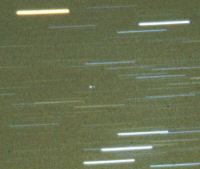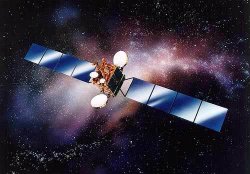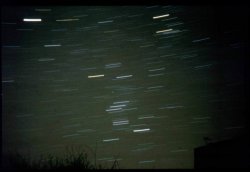A 'Mystery Object' in Orion
The Geminids of 2001 were met with clear skies across much of the country, allowing the acquisition by the Association's Meteor Section of its largest-ever visual data set on the shower; a comprehensive report on the activity is essentially complete and will be submitted to the Journal in due course. Clear but cold conditions were welcomed by this observer at his location in West Sussex (Lat 50°49.8' N 0°48.3'W), where they allowed a lengthy (4 hour) watch on maximum night Thursday-Friday December 13-14, as well as a further couple of hours on the following night. On both nights, photography of bright Geminids was attempted using an undriven camera equipped with a 29 mm f/2.8 wide-angle lens and Kodak Elite/Ektachrome 400 ISO colour slide film. Bright meteors were relatively scarce, and 5.17 hours' photographic exposure over the two nights yielded only a couple of rather unspectacular Geminid trails, both from Dec 13-14. The camera was aimed to the south at an elevation of about 50 degrees, with the Geminid radiant skirting through the uppermost part of the field of view around midnight UT.
Initial inspection of the processed film revealed what was, at first, taken to be a flaw on the first exposure on Dec 13-14, this appearing as a 'dot' above the trails of Orion's Belt stars (Figure 1).
A similar dot was present on the next frame, but not on any later exposures from the same night. Interest was really piqued when a similar dot was found on the first frame from Dec 14-15. The realisation dawned that this might be the image of a geostationary satellite.
Approximate RA and Dec positions for the point image were determined from the photographs (for the end of exposure) and are listed below with the exposure times and reductions to altitude and azimuth:
- Dec 13-14 2332 - 2345 UT. RA 05h 38m Dec +3.5° Alt 41.4° Azi 171.6°
- Dec 13-14 2345 - 2359 UT. RA 05h 50m Dec +4.0° Alt 41.9° Azi 172.2°
- Dec 14-15 2334 - 2352 UT. RA 05h 43m Dec +4.0° Alt 42.1° Azi 174.8°

Fig 2. Slight trailing and dimming
It seems reasonable to presume that this 'mystery object' is a geostationary satellite, whose solar panels were favourably illuminated around midnight UT when in opposition to the Sun. Close inspection of the enlarged image in Fig 2 shows slight trailing and dimming followed by re-brightening.
The object's position in the sky is inconsistent with the usual location of geostationary satellites visible from the British Isles.

Fig 3. Eutelsat W3
According to Maurice Gavin these should appear about 7 degrees south of the celestial equator at our latitudes - i.e., below Orion's Belt. Assuming this object to lie at the distance of geostationary orbit at 35,900 km, its azimuth places it around longitude 7oE. In the list of geostationary satellites at http://www.satsig.net/sslist.htm the best candidate appears to be Eutelsat W3, stationed at 7.0o E. Nick James has pointed out that rather than 'hovering' precisely on the equator, geostationary satellites describe a slow figure-8 around a mean position. Perhaps the object serendipitously caught on film during the 2001 Geminids was Eutelsat W3 near the northern end of its loop?
The geostationary satellites imaged in the past by Maurice Gavin have typically been rather faint, requiring time exposures with a telescope to be recorded. Presumably, given its detection with a relatively insensitive photographic system, this object is relatively large. Eutelsat W3 is based on Alcatel's Spacebus 3000B2 design, with a mass of 3180 kg and two large solar panels with a total span of 29 metres.
